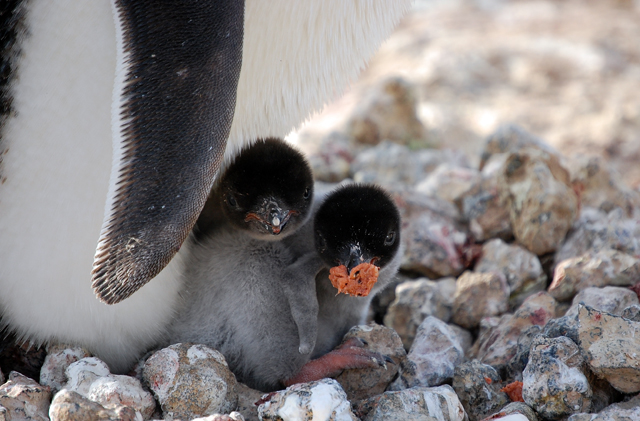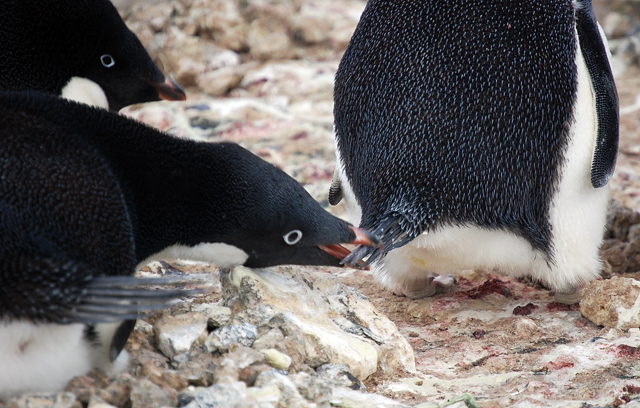The penguin perspectiveThese 'cuddly' birds live on the edge — and have something to teach us about lifePosted January 28, 2011
Ask anyone to describe an Adélie penguin and you will inevitably get the terms cute, fluffy, lovable, adorable and playful. These closely held images are perpetuated in part by the portrayal of penguins in children’s cartoons as fun-loving, friendly and cuddly characters. Marketers count on these images as they use penguins to sell soft drinks, ice cream, warm clothes and a myriad of other products. Penguins truly are one of the feel-good animals. But there is very little fun loving or playful about the lives of Adélies. They live in the most brutal environment in the world — on the brink of catastrophe at all times. They survive by running the behavior code embedded in their genes, which were laid down by countless successful generations before them. There is no wasted motion; energy is too expensive here. Living and reproducing takes it all. During the cycle of the seasons, these birds may experience temperatures as low as minus 30 degrees Celsius, and it rarely gets above freezing, even in the summer. Add wind that can blow steady for days at 65 to 80 kilometers per hour, and you have the challenge of the Southern Ocean. Daily life means standing barefooted on the ice, hoping your coat of feathers is enough to defend your body heat against the wind. Eating means swimming through subfreezing water chasing krill or small fish while avoiding the sharp eye and voracious appetite of leopard seals. But nature was not stingy with adaptations for penguin survival. Its physiology allows rapid fat deposition, for maximum feathers per square surface area, and a body form unparalleled in hydrodynamic design. In one year, they can gain and lose 30 percent of their body mass — twice. As I sit in the breeding colony at Cape Royds on Ross Island near McMurdo Station And that’s before I would have to look for my own food. We are the fragile species. They must stare at us and wonder, “What are those people doing here?” Watching penguins is habit forming, but luckily neither fattening nor a health risk. After four seasons and 1,500 hours observing these birds overcome the obstacles of survival, I still get the feeling I am watching them for the first time. Every day a new drama unfolds, and I see pieces of us in their behavior and lessons to learn. The gift of returning to the same colony every year allows me to get to know breeding pairs well. More than a snapshot, I have collected a family album of their lives. Unlike other birds and most animals, but similar to humans, their faces are perpendicular to their bodies and their legs in line with their backbones. These attributes add to their humanness and their engaging appeal. Giving human traits and feelings to these charismatic creatures is called anthropomorphizing. Not scientific, but it is hard to resist. Just like us, they squabble with their neighbors and mate. Nests on the inside of a breeding neighborhood are safer than ones on the edge. Inside adults coming and going from the center must walk through the property of its neighbors. Pecks and jabs abound, and the intruder runs quickly to avoid as much punishment as possible. The neighbor’s nest rocks are so much easier to get than the ones way over there, so why not steal one when its owner isn’t looking? While Murray is stealing from Joe on one side, I have seen Larry steal from Murray on the other side. The roulette cycle of rocks throughout the group never stops. It reminds me of borrowing tools in the neighborhood where I grew up. At some point, we did not know which wrench really belonged to whom. Penguins divorce and remarry. The Antarctic breeding season is short. A male will build a nest and wait for last year’s mate to return. But not long, for time is valuable and so new courtships occur. Returning females unable to locate their former beau will similarly seek another male. Mates returning late may find their place taken. Fights do occur, but most disputes end peacefully, with very little blood shed.1 2 Next |



For USAP Participants |
For The Public |
For Researchers and EducatorsContact UsU.S. National Science FoundationOffice of Polar Programs Geosciences Directorate 2415 Eisenhower Avenue, Suite W7100 Alexandria, VA 22314 Sign up for the NSF Office of Polar Programs newsletter and events. Feedback Form |




